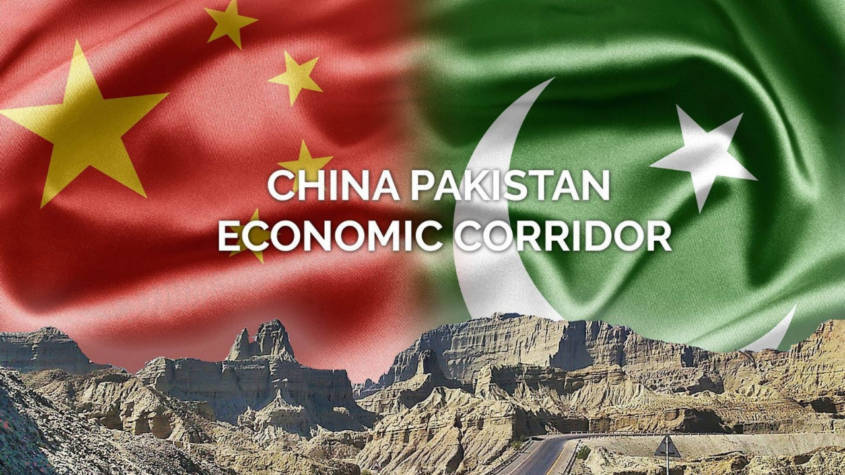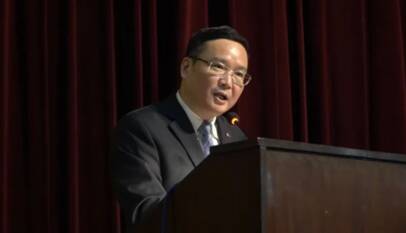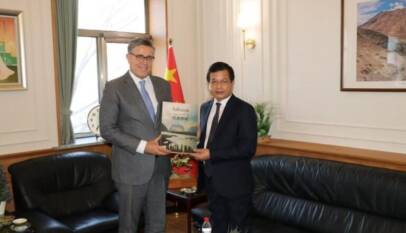CPEC is a saviour of global economy amid the outbreak of COVID-19
The outbreak of COVID-19 has posed multiple challenges to global stability and development. An international and coordinated response is a need of the hour to address the menace of global pandemic COVID-19. In this regard, China’s Belt and Road Initiative (BRI) offers an excellent opportunity to address the challenges of socio-economic development at the global level. BRI is an inclusive project and inviting countries to CPEC, a flagship project of BRI, will help to tackle the global economic crisis. As resource utilization is vital to economic growth, including Middle-East to CPEC will help to pool resources and revive the economy. A “CPEC-Middle East Forum” should also be formed to reap the maximum advantages of regional integration. Moreover, Pakistan needs to accelerate the development of Special Economic Zone (SEZ’s) under CPEC to revive its economic growth.
World Economic Outlook report by IMF stated that the MENA region will suffer a loss of US$ 323 billion due to COVID-19 and lower oil prices. It is equivalent to 12 percent of GDP of region. Although all countries of MENA would be impacted but the major losers would be oil exporting countries from Middle East. The outlook highlighted that energy export dependent countries will suffer a loss of US$ 295 billion. It has been foretold that oil exporting countries of region can lose revenue up to US$ 23 billion in 2020 due to lower demand of oil in global market. COVID-19 and lower prices will also introduce many other problems. For example, it will also give rise to debt of countries which will touch the figure of US$ 1.46 trillion. Fiscal deficit will be much higher and can reach to the level of 10 percent of GDP. The situation will be further complicated due to active conflicts in the region.
It will have spill over affect for other countries, as millions of workers from other countries are working in Middle East. The social and economic cost would be much more than these figure. For example, most of the Middle Eastern countries are dependent on the imported food to ensure food security. It has been warned by UN agencies and many organizations that due to COVID-19 the food trade and supply chains will be impacted. There is fear of escalation in prices of food, which will further aggravate the problem in the region.
The situation will become more complicated as the traditional partners of Middle East like USA, Europe etc. are also going through the worst attack of COVID-19. Their economies are also struggling to bear the shock. Millions of people have lost job, which will have severe implications for economy and consumption of those countries. On top of that the domestic energy market of USA will not allow it to help region, rather it will be a competitor. Therefore, traditional partners would not be able to help the Middle Eastern economies.
Pakistan has vast land, China has technology and Middle Eastern countries have resources. It presents an excellent proposition for cooperation
Hence, the region will have to look for new avenues for its economic revival and ensure availability of food and daily essential. Fortunately, CPEC has emerged as one of such avenues. Middle East has already experience to work China and Pakistan for decades. China is already engaged with region and in recent times it has emerged as the biggest trade partner and investor in the region. A report by BESA Center stated that the bilateral trade between China and Middle East has crossed the figure of US$ 294 billion. China’s investment in region has been exhibiting a positive trend and it has crossed the figure of US$ 93 billion between 2013-2019. In 2018 China at China-Arab Forum announced that it will be investing US$ 23 billion in oil and gas sector in Arab countries. China is also busy in striking deal with individual countries. China signed a deal of US$ 10 billion to invest in refinery in addition to copper, food, energy and other sectors. China has also signed deal with Iran for 25 years to invest almost US$ 400 billion in different sectors. China will be given preference for future bidding and investing in Iran. It has also signed deals with other countries in the region.
Pakistan is also a close ally of region. Millions of Pakistanis are working in different countries and are contributing billions of dollars in national economy. Pakistan is among one the bigger importer of oil from the region.
COVID-19 has provided an opportunity to further strengthen the relation. As all countries are facing problems due to COVID-19 and there is need of cooperation to revive the economies and give impetus to growth. Moreover, there is need to pool the resources and work together, as no individual country or region will be able to revive economy at individual level. In present circumstance, China-Pakistan Economic Corridor (CPEC) can provide an opportunity to pool resources, overcome the problem and revive economy. It would be a win-win proposition for Pakistan, Middle East and China. Middle East will be able to diversify their investment portfolios. The biggest catch for Middle East would be to ensure the food supply to meet the local demand. China will benefit by finding new place for export of their products to Middle East under the umbrella of CPEC. It will also help to ensure un-interrupted supply of oil to China through CPEC route.
However, to materialize the proposal China, Pakistan and Middle East will have to devise a formula to materialize the proposal. The entry point can be Special Economic Zones (SEZs). China and Pakistan should look for individual countries from Middle East to invest in different SEZs. Each country from the region should be offered a dedicated zone for cooperation. Then devise a formula for investment and benefit sharing. The investment should be divided in two categories, 1) construction of SEZs, 2) industrial development in SEZs. Second area of cooperation can be investment in backward linkages of SEZs. It will give impetus to local economy and will create good investment opportunities for all countries. The construction will also create good livelihood opportunities for un-skilled labour.
Third area of cooperation can be agriculture sector. For that purpose, Pakistan and China can look for ways to enhance the scope of MoU on agriculture and try to expand it to Middle East. Pakistan has vast land, China has technology and Middle Eastern countries have resources. It presents an excellent proposition for cooperation. Therefore, MoU can be refined on these lines. It would be extremely important and win-win scheme. As China and Middle East both are looking for quality food and Pakistan is looking for investment in agriculture to modernize it.
Fourth, all partners can work to identify areas for work to benefit from the Fourth Industrial Revolution. The MoU on Science and Technology under CPEC provides a good opportunity to start the work. The cooperation will help Pakistan and Middle East to lessen reliance on Western markets. It will also help to create domestic capability to benefit from the fourth industrial revolution.
Lastly, to materialize all these proposed intervention China, Pakistan and Middle East need to work on the possibility to transfer the CPEC into a tri-lateral venture. The starting point can be to work on possibility to establish a “CPEC-Middle East Forum” like China-Arab Forum.
(April 20): Pakistan’s economy is in a shambles. It is struggling to find ground. International lenders and partners are looking for repayment of their debt.
Livelihood opportunities are scarce, absolute poverty has gripped 25% of the population and large-scale industries’ production is on the wane. Agriculture production is facing formidable challenges and exports are not picking up pace.
In a nutshell, the government is struggling to bring the economy back on track. Earlier, there were some signs of improvement, but the economy suddenly took a beating with the emergence of Covid-19 pandemic.
Coronavirus has posed multiple challenges to every sector of the economy. It is feared that exports will go down as major export destinations of Pakistan have been struck hard by the Covid-19.
The United States, United Kingdom, Germany, Spain and Italy are Pakistan’s major export destinations, along with China, but these countries are going through the worst phase of the pandemic. Thousands of people have died there and their economies have suffered immense losses.
Millions of people have filed jobless claims in the US. It is predicted that the impact of the virus will be felt for a longer period of time. These factors will hurt the purchasing power of consumers, leading to lower demand for imported commodities.
It will have negative implications for Pakistan’s exports. We tried to foresee the impact by building three scenarios.
Conservative estimates show that Pakistan can lose $617 million (10% shock), $1.2 billion (20% shock) or $1.8 billion (30% shock) in export revenue in three months (April-June). The situation can be more complicated if export destinations do not come out of the Covid-19 shock soon. The impact on exports will directly hit the export-related industries, resulting in closure of businesses and joblessness.
Agriculture will be another sector that will bear the brunt of Covid-19 devastation. It has hampered harvesting as Rabi crops are at the picking stage. Lockdown in the country is making it extremely difficult for farmers to go for smooth harvesting.
Apart from this, agriculture is threatened by climate change. It is certain that rains in the past two months will push down production and affect the quality of produce.
We built four scenarios by assigning a certain percentage of shock. Scenario-1 covers 5% shock, scenario-2 10% shock, scenario-3 15% shock and scenario-4 20% shock.
According to these scenarios, the climatic factors can reduce wheat production by 1.35 million tons, 2.7 million tons, 4.05 million tons and 5.4 million tons respectively. It will restrict per capita wheat availability to 111 kg, 105 kg, 99 kg and 93 kg respectively.
Inclusion of post-harvest losses will further lower the per capita wheat availability to 105 kg, 100 kg, 94 kg and 89 kg respectively for the four scenarios.
The situation for other major Rabi crops such as gram, potato, onion, etc is also not very good. It is feared that output of all these crops will fall. The situation will turn grim if the potential loss due to locust attacks is included.
The Covid-19 and climate change will have a damaging impact on Pakistan’s economy. Major repercussions will be felt in income and jobs of people, businesses and inflation.
Industrial closure due to lower exports will create joblessness in urban and semi-urban areas. It will increase urban poverty.
Poor performance of the agriculture sector will slash income and revenue of the farming community. It is feared that rural poverty will also increase and lower production of agricultural commodities will trigger price hike, especially in food items.
Owing to the global spread of Covid-19, it has made it difficult for Pakistan to look outside as all countries are going through this shock. It has been forecast by the IMF, World Bank and World Economic Forum that repercussions of the Covid-19 will be felt for longer periods. They see trade as a major victim with overall impact of $2-3 trillion.
Silver lining
Fortunately, Pakistan can absorb the shock and recover by focusing more on the China-Pakistan Economic Corridor (CPEC). However, it will require visionary planning and rigorous implementation.
The government would have to look for low-hanging fruits according to needs of the country and divert attention and resources to those areas without compromising on long-term goals.
At present, Pakistan needs to create jobs and business opportunities to make up for the loss of business and employment. CPEC can help to create jobs which will, in turn, spark business opportunities by stimulating domestic consumption.
For that purpose, the government should immediately start building the Special Economic Zones (SEZs) under CPEC. It will give a boost to the construction sector and provide job opportunities.
The government should also take steps to forge backward linkages with the SEZs. It will give a fresh impetus to the construction sector as well as bring employment to the people. It is expected that only construction work will create hundreds of thousands of jobs, especially for the unskilled labour.
The completion of SEZs and backward linkages will have multiple benefits. First, it will bring investment in the country, which is direly needed at this point in time, and instill confidence in investors, especially from China.
Second, the forging of linkages will help industries to start the production process immediately. Most of the SEZs depend on domestic raw material for the production of finished products.
For instance, the industries in the Rashakai SEZ will mainly rely on agricultural produce and minerals from Khyber-Pakhtunkhwa as well as other parts of the country.
Similarly, the Allama Iqbal SEZ is being established for garment and textile production, which will require backward linkages with the cotton-producing areas and allied industrial areas.
The backward linkages will provide sustained sources of livelihood for the people. It will be a win-win situation in the short as well as long term.
In the short run, employment avenues will emerge and domestic consumption will get a boost. In the long run, investment will go up and industrialisation will be promoted.
Moreover, minimum government investment will be required in the SEZs as industrial units, office buildings and other structures will be constructed mainly by the private sector through their own resources.
Thus, Pakistan should start work immediately on all the SEZs. To ensure a smooth flow of investment, the country needs to improve the business environment by establishing efficient policy mechanisms.
In addition to this, the government should provide basic services like water, sanitation, electricity, gas, etc at a swift pace.
Pakistan must keep in mind that it cannot afford to lose this opportunity as it is the only available option in these tough times. The cost of loss of opportunities will be huge.
Chinese Ambassador highlights significance of Third Plenary Session for China-Pakistan cooperation
The Third Plenary Session of the 20th Central Committee of the Communist Party of China ha…









